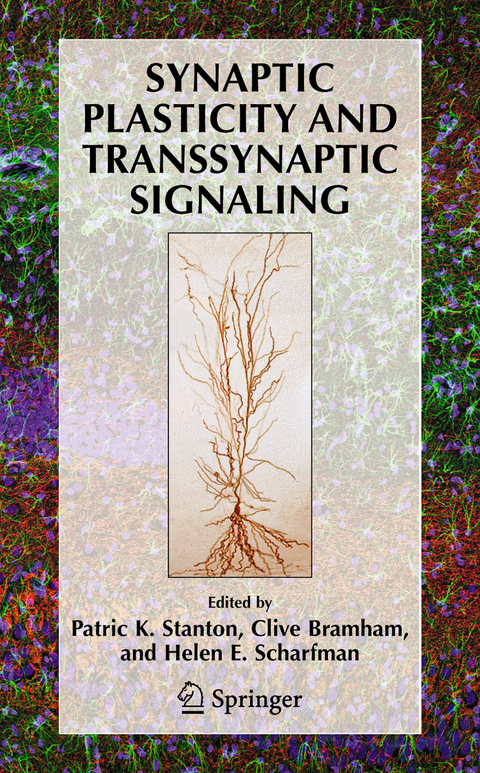
Synaptic Plasticity and Transsynaptic Signaling
Springer-Verlag New York Inc.
978-0-387-24008-4 (ISBN)
Brain functions are realized by the activity of neuronal networks composed of a huge number of neurons. The efficiency of information transfer within the networks is changeable. Even the networks themselves can change through experience. Information transfer between neurons is performed at the synapse (the site of the neurons’ contact) by release of neurotransmitters from the pre-synaptic cell and capture of neurotransmitters by the post-synaptic cell. The amount of released neurotransmitter or the efficacy of capture can change. Moreover, synapses are found to be newly formed upon activity or abandoned upon inactivity. These changes are called "synaptic plasticity".
This text focuses on one component of synaptic plasticity called transsynaptic signaling, or communication of synapses during their formation.
The Three Faces of Norepinephrine: Plasticity at the Perforant Path-Dentate Gyrus Synapse.- The Histaminergic System in Brain: Memory and Synaptic Plasticity.- Spike Timing Dependent Plasticity of Rat Hippocampal and Cortical Synapses and Control by Muscarinic Transmission.- Hydrogen Peroxide Regulates Metaplasticity in the Hippocampus.- Neuronal Plasticity and Seizure Spread in the Entorhinal Cortex and Hippocampus of Amygdala Kindled Rats.- Presynaptic Ionotropic GABA Receptors.- Activity Dependent Regulation of the Cl? Transporting System in Neurons.- The Truth About Mossy Fiber Long-Term Potentiation.- The Gluzinergic Synapse: Who’s Talking and Who’s Listening?.- Zinc Dyshomeostasis in Neuronal Injury.- BDNF as a Trigger for Transsynaptic Consolidation in the Adult Brain.- On the Role of Neurotrophins in Dendritic Calcium Signaling.- Brain-Derived Neurotrophic Factor (BDNF) and the Dentate Gyrus Mossy Fibers: Implications for Epilepsy.- Transsynaptic Dialogue Between Excitatory and Inhibitory Hippocampal Synapses via Endocannabinoids.- Talking Back: Endocannabinoid Retrograde Signaling Adjusts Synaptic Efficacy.- Synaptic Vesicle Recycling as a Substrate for Neural Plasticity.- Retrograde Messengers in Long-Term Plasticity of Presynaptic Glutamate Release in Hippocampus.- Hippocampal Long-Term Depression as a Declarative Memory Mechanism.- NMDA Receptors: From Protein-Protein Interactions to Transactivation.- The Phases of LTP: The New Complexities.- CREB: A Cornerstone of Memory Consolidation?.- Synaptic Plasticity in the Central Nervous System: A Role for Calcium-Regulated Adenylyl Cyclases.- Rapid Nuclear Responses to Action Potentials.- Synaptic Dialogue: Substrate for Protein-Synthesis-Independent Long-Term Memory.- Coordinated Pre- and PostsynapticChanges Involved in Developmental Activity-Dependent Synapse Elimination.- Recent Advances in the Role of Integrins in Developmental and Adult Synaptic Plasticity.- Consolidation: A View from the Synapse.- Morphological Plasticity of the Synapse.- Role of the Spine Apparatus in Synaptic Plasticity.- Amyloid-? As a Biologically Active Peptide in CNS.
| Zusatzinfo | 119 Illustrations, black and white; XIV, 557 p. 119 illus. |
|---|---|
| Verlagsort | New York, NY |
| Sprache | englisch |
| Maße | 165 x 248 mm |
| Themenwelt | Medizin / Pharmazie ► Medizinische Fachgebiete ► Neurologie |
| Medizin / Pharmazie ► Studium | |
| Naturwissenschaften ► Biologie ► Humanbiologie | |
| Naturwissenschaften ► Biologie ► Zellbiologie | |
| ISBN-10 | 0-387-24008-X / 038724008X |
| ISBN-13 | 978-0-387-24008-4 / 9780387240084 |
| Zustand | Neuware |
| Haben Sie eine Frage zum Produkt? |
aus dem Bereich


